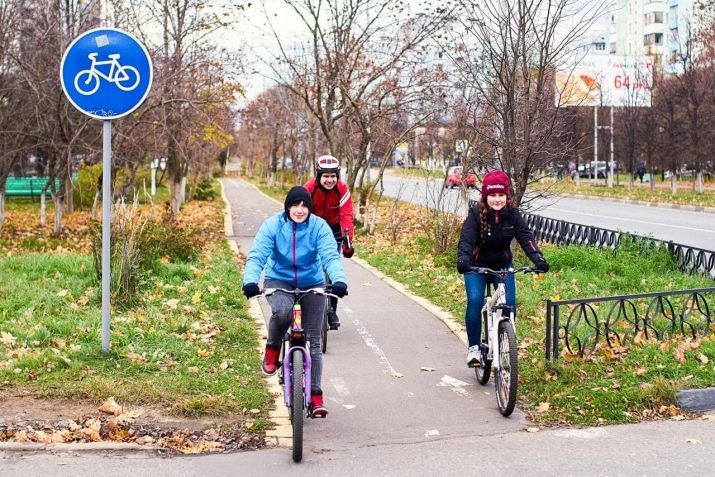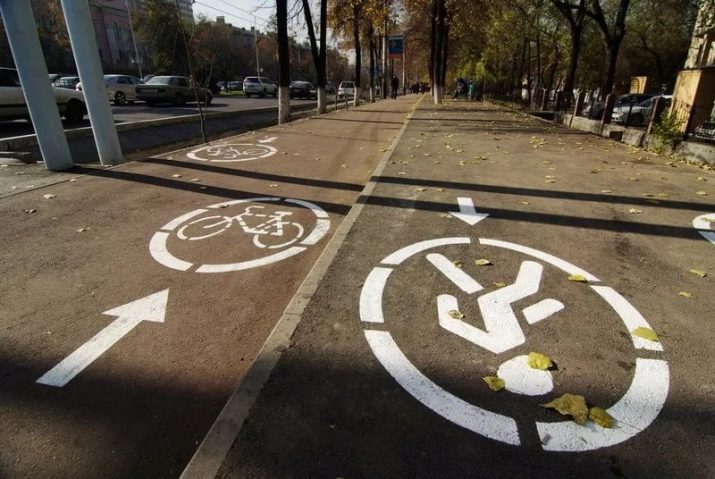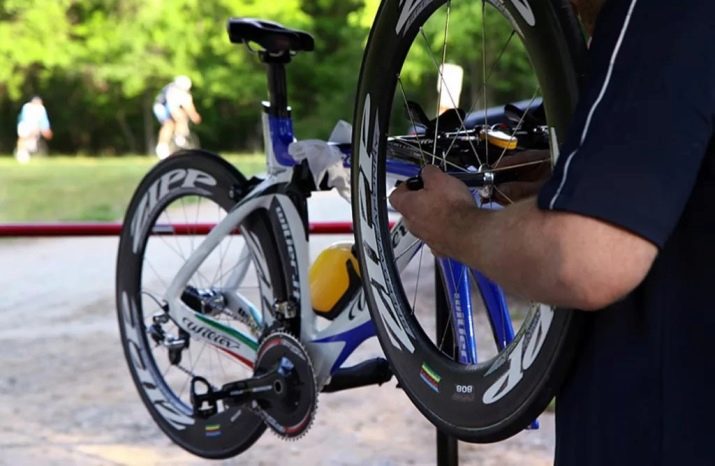A bicycle can physically pass where a car or even a motorcycle cannot pass. But his movement in the city is strictly regulated. And it is important for every novice cyclist to know exactly how to use the allocated tracks.

Varieties
Based on the norms of the Russian GOST, it is necessary to distinguish between bicycle and bicycle paths proper. In the first case, it is intended for separate or joint with people moving on foot, in the second it is intended exclusively for cyclists.
What unites the situations is that special designating road signs must be used.


But there is still a special term - a strip for cyclists. This can only be called a bicycle path located on the designated part of the highway and having technical means and barriers separating it from the carriageway of the road.

Lane for cyclists must be equipped with road signs and indicating plates. The location of the bicycle and bicycle paths always strictly corresponds to the technical documentation for the planning of the territory. It is required to coordinate their placement with local government agencies.
Regardless of the type, the track should be completely safe in itself. It is also unacceptable for her to create any threat to motorists, highways, pedestrians, or anyone else's property.

What it is?
Like many other important safety issues, bicycle lanes located on public highways are clearly described by GOST standards.As stated there, in addition to improving the safety of moving people and vehicles, the developers of the standard focused on increasing the capacity of highways. The definition clearly states that the bicycle lane must be on a separate canvas. But sometimes they allow her to put:
- at the bottom of the embankment;
- out of the grooves;
- in advance organized berm.

When approaching any specialized construction, the bike path can be set on the side of the road.
Wherein provide for delimitation from the carriageway using fences or dividing strips. One-way driveways should be done from the windward side, and two-way driveways - preferably on both sides of the road. The windward side is determined by the wind that dominates in the summer. Whenever possible paths are made outside the carriageway, especially if traffic exceeds 2000 cars per day.

The sizes of bicycle paths deserve special attention. The width of the strip for cyclists can be 1.2 or 0.9 m. At the same time, the shoulders have the same dimension of 0.5 m. If there is no bend, the radius of the curves should be from 15 to 50 m, and if the bend is arranged, this figure will already be from 10 to 20 m. GOST prescribes the design of two-way tracks with an expected flow of not more than 70 cyclists per hour; if it is more, you have to limit yourself to one-way operation.

The distance requirements are as follows:
- between the edge of the path and the edge of the road, as well as trees - 0.75 m;
- to the pedestrian sidewalk - 0.5 m;
- to the stopping place of cars and public transport - 1.5 m.
The lane separating the carriageway from the bike path must be at least 2 m. The exception is for places with particularly cramped conditions. They form a dividing strip with a width of 1 m exactly. It should be raised above the roadway at least 0.15 m. The use of borders, barriers and parapets is practiced.

GOST provides for the intersection of roads with cycle tracks only with a normal radius of visibility.
If you know that cars travel faster than 80 kilometers per hour, and at least 50 cyclists will pass in an hour, a one-level intersection is allowed only when using a traffic light. The intersection points in any case should be equipped with lighting devices at a distance of 60 m from the point where cars and bicycles converge. All such places are equipped special road signs and mark up. In especially difficult situations, equipment for overpasses or tunnels is provided.

The bike path sign looks like a white bike on a blue background. The sign is characterized by a round shape. Classic tracks, most often used in our country, are made directly from asphalt. In a number of foreign countries, large-format tiles are used.
In Russia, acrylic-coated tracks are increasingly used in recent years.
If you start from safety considerations for riders, then you can give preference to rubber crumb, Of course, all three options differ not only in practical properties, but also in texture.

Separate attention deserves guidance SNiP. They prohibit, by the way, to narrow the carriageway at the intersection with cycle paths. The tracks themselves must be:
- in residential areas;
- in the industrial area;
- on highways with adjustable traffic;
- on city streets of local importance.

The greatest longitudinal slope on the street should not exceed 30 ppm. On a stretch of up to 300 m, the slope can be a maximum of 60 ppm. The value of the transverse slope should range from 15 to 25 ppm. Going beyond these boundaries is categorically unacceptable. The standard throughput of a bike path should be 300 people traveling in 60 minutes.

Road signs and markings
Something about road signs and markings on and around bicycle paths has already been said. They were seen, of course, by almost all people.But to know such information is still completely insufficient. On the road, bicycle lanes on the left are delimited by a solid marking line. On the right is the curb. If the bike lane is highlighted on a pedestrian walkway or sidewalk, it is marked with solid white lines to the right and left. Wherein An optional bicycle pattern is used to further emphasize the purpose of the strip.

Such sites are well suited for leisurely movement. But for a quick ride without leaving the roadway, they are not suitable. In a completely different way, isolated paths intended only for cyclists are marked.
They are usually used in parks where you can distinguish between pedestrian and bicycle flows. A solid yellow line is drawn around the perimeter. If the width of the track allows, it is divided into 2 opposite directions. In this case, two solid white lines are drawn in the middle, between which there is a small gap. Triangular signs with a red border and a black bicycle on a white background are placed next to paths designated only for cyclists.

What traffic rules do cyclists need to know?
Even if a cyclist rides along a designated track, there are rules that must be followed.
Important: as soon as a person leaves a bicycle and begins to roll it, carry it or do something else, immediately the status of the cyclist changes to the status of a pedestrian.
Another nuance that must not be forgotten - driving on a designated track while intoxicated is punishable by a fine of 1 to 1,5 thousand rubles. Going somewhere on a faulty bike is strictly prohibited. If a breakdown is found along the road, the owner of the vehicle must repair it himself as soon as possible.

Reflectors must be placed so that they are clearly visible. You must go at a speed that does not exceed the permitted level. But it is necessary to take into account the actual conditions along the way (including visibility) and the ability to safely perform the required maneuvers.
Traffic regulations provide for special gestures with which the cyclist is obliged to notify other road users that he decided to turn or park.
Movement to the left is indicated by stretching to the side of a straight left hand or showing bent at a right angle upward of the right hand. Depending on which hand is more convenient to use, a turn to the right is indicated by a mirror (with respect to a turn to the left) method. The stop is shown by raising the left (right) hand, respectively. Signals are given before they begin to perform the maneuver, and stop them when the maneuver is over.

A cyclist, like a motorist (motorcyclist), must pass pedestrians. It is recommended to drive along tracks marked on the edge of the road or on pedestrian sidewalks at a speed of no more than 20 km / h.

Who is allowed to move?
Current regulations prohibit mopeds from accessing bicycle lanes in the proper sense of the word. At the same time, they are allowed to move on the right side of the roadway in no more than one row, as well as along the lane reserved for cyclists. Pedestrians can walk along bicycle paths (with the exception of cycle paths) only if there is no or closing for repair (overlapping for another reason):
- sidewalks;
- bike paths;
- roadsides;
- walking paths.

In addition to the fine for driving on a bicycle path by car, motorcycle, moped, there is also a fine of 500 rubles for stopping there, except in cases expressly prescribed in the SDA.
But there is another question regarding the passage of a pram on a bicycle path. In the rules, such travel is not specified in any way. A baby carriage, unlike a bicycle, is not a permitted vehicle for driving on a bicycle path. Therefore, cyclists have every right to demand that the owners of the strollers leave the traffic area.

The following video reveals the main traffic rules for cyclists.







